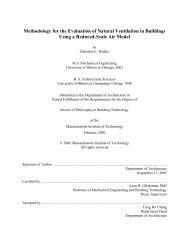CHAM Case Study - Natural Convection Flow in a Nuclear Reactor
CHAM Case Study - Natural Convection Flow in a Nuclear Reactor
CHAM Case Study - Natural Convection Flow in a Nuclear Reactor
- No tags were found...
You also want an ePaper? Increase the reach of your titles
YUMPU automatically turns print PDFs into web optimized ePapers that Google loves.
Body Force (Buoyancy)Liquid Na convection zoneF βρg(T T )Air convection zoneF ρgResistance force <strong>in</strong> the porous medium zone:FKU2whereK: Pressure resistance coefficient. (This is different <strong>in</strong> each zone.)p: densityU: velocityRadiation
Energy source <strong>in</strong> the porous medium zoneCptefT (liqU iCpliqT )xixikefTxiSVliq liqCpliqT (liqU iCpliqT )txixikefTxiSVsolidsolidCptsolidTwherekVefCpsolefV1solidkVVsolidliqliqliqCpVliqsolidkVliqsolidsolidCpsolidPressure value <strong>in</strong> the air convection zone boundaryThe value of pressure <strong>in</strong> the air convection zone boundary is renewed while it is calculatedfrom the next experience equation.PoutoutghoutiPfi1,9i 1, 7PfiP<strong>in</strong>outg(hh<strong>in</strong>)iPfi1,9i 1, 2PfiPfi0.5nkioutmA2iPfi0.5nki<strong>in</strong>mA2i
ResultMaximum temperature [C˚]Experimental data:PHOENICS result:550 ˚C540.6699 ˚CTemperature distribution (steady)Pressure drop [MPa] <strong>in</strong> Na convectionzoneExperimental data: 2.5PHOENICS result: 2.51
tem trature[℃]mass flow rate[kg/ s]Pressure distribution (steady)Air flow rate <strong>in</strong> the air convection zone3.43.353.33.253.23.153.13.0532.952.90 10 20 30 40time[hour]mass flow rate[kg/ s]Maximum temperature <strong>in</strong> the liquid Na convection zone5405205004804604404204000 10 20 30 40tim e[h]
ConclusionSuch is the flexibility of PHOENICS that a model captur<strong>in</strong>g the majorcomponents of the nuclear reactor system was able to be constructed frombuilt-<strong>in</strong> objects. Additional user-def<strong>in</strong>ed functionality was <strong>in</strong>troduced viaGROUND cod<strong>in</strong>g. The f<strong>in</strong>al model performed well aga<strong>in</strong>st experimental databoth for its normal steady-state operation and its transient predictions agreedwell with data gathered from a controlled and monitored cool<strong>in</strong>g-systemfailure.______________________<strong>CHAM</strong> Ltd, Bakery House, 40 High Street, Wimbledon Village, London SW19 5AU, UKTel: +44 (0)20 8947 7651 Fax: +44 (0)20 8879 3497 Email: phoenics@cham.co.ukWeb: http://www.cham.co.uk
















